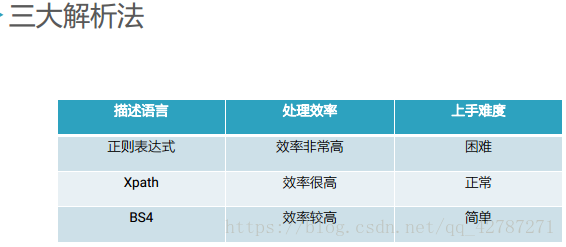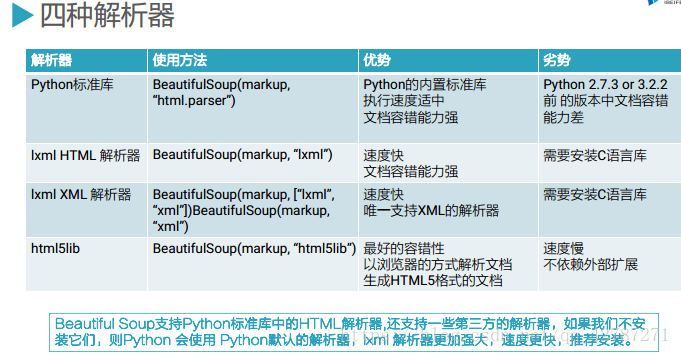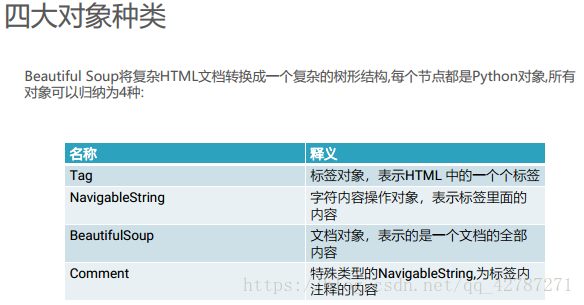python爬虫系列三:html解析大法
发布时间:2019-09-23 17:04:21编辑:auto阅读(2322)
Beautiful Soup 是一个可以从HTML或XML文件中提取数据的Python库。
它能够通过你喜欢的转换器实现惯用的文档导航,查找,修改文档的方式。
在爬虫开发中主要用的是Beautiful Soup的查找提取功能。
Beautiful Soup是第三方模块,需要额外下载
下载命令:pip install bs4
安装解析器:pip install lxml


from bs4 import BeautifulSoup
html_doc = """
<html><head><title>The Dormouse's story</title></head>
<body>
<p class="title"><b>The Dormouse's story</b></p>
<p class="story">Once upon a time there were three little
sisters; and their names were
<a href="http://example.com/elsie" class="sister"
id="link1">Elsie</a>,
<a href="http://example.com/lacie" class="sister"
id="link2">Lacie</a> and
<a href="http://example.com/tillie" class="sister"
id="link3">Tillie</a>;
and they lived at the bottom of a well.</p>
<p class="story">...</p>
"""
#创建一个bs对象
#默认不指定的情况,bs会选择python内部的解析器
#因此指定lxml作为解析器
soup=BeautifulSoup(html_doc,"lxml")
----------
1. 解析网页后的类型及格式化
print(type(soup)) #<class 'bs4.BeautifulSoup'>
print(soup.prettify()) #格式化 答案如下:
<html>
<head>
<title>
The Dormouse's story
</title>
</head>
<body>
<p class="title">
<b>
The Dormouse's story
</b>
</p>
<p class="story">
Once upon a time there were three little
sisters; and their names were
<a class="sister" href="http://example.com/elsie" id="link1">
Elsie
</a>
,
<a class="sister" href="http://example.com/lacie" id="link2">
Lacie
</a>
and
<a class="sister" href="http://example.com/tillie" id="link3">
Tillie
</a>
;
and they lived at the bottom of a well.
</p>
<p class="story">
...
</p>
</body>
</html>
2. 基本操作
#1.标签选择法 缺点:只能猎取到符合条件的第一个
#(1)获取p标签
print(soup.p) #<p class="title"><b>The Dormouse's story</b></p>
print(soup.a) #<a class="sister" href="http://example.com/elsie" id="link1">Elsie</a>
#(2)获取a标签的herf属性:因为标签下的内容是以键对形式体现出来
print(soup.a["href"]) #http://example.com/elsie
#(3)获取标签的内容
print(soup.title.string) #The Dormouse's story
print(soup.a.string)#Elsie
----------
3.遍历文档树
#1.操作子节点:contents ,children(子节点)
print(soup.body.contents) #得到文档对象中body中所有的子节点,返回的列表,包括换行符
print(soup.body.children) #<list_iterator object at 0x0000000002ACC668>
#这个意思是意味着返回的是列表迭代器,需要用for 将列表中的内容遍历出来
for i in soup.body.children:
print(i)
answer:
<p class="title"><b>The Dormouse's story</b></p>
<p class="story">Once upon a time there were three little
sisters; and their names were
<a class="sister" href="http://example.com/elsie" id="link1">Elsie</a>,
<a class="sister" href="http://example.com/lacie" id="link2">Lacie</a> and
<a class="sister" href="http://example.com/tillie" id="link3">Tillie</a>;
and they lived at the bottom of a well.</p>
<p class="story">...</p>
#2.操作父节点:parent(父节点),parents(祖父节点)
print(soup.a.parent)
print(soup.a.parents)
<p class="story">Once upon a time there were three little
sisters; and their names were
<a class="sister" href="http://example.com/elsie" id="link1">Elsie</a>,
<a class="sister" href="http://example.com/lacie" id="link2">Lacie</a> and
<a class="sister" href="http://example.com/tillie" id="link3">Tillie</a>;
and they lived at the bottom of a well.</p>
#兄弟节点
next_siblings
next_sibling
previous_siblings
previous_sinbling
----------
4、搜索文档树
#搜索文档树
#(1)查询指定的标签
res1=soup.find_all("a")
print(res1) #返回所有的a标签,返回列表
answer:
[<a class="sister" href="http://example.com/elsie" id="link1">Elsie</a>, <a class="sister" href="http://example.com/lacie" id="link2">Lacie</a>, <a class="sister" href="http://example.com/tillie" id="link3">Tillie</a>]
#(2)正则表达式
#compile():声明正则表达式对象
#查找包含d字符的便签
import re
res2=soup.find_all(re.compile("d+"))
print(res2)
answer:
[<head><title>The Dormouse's story</title></head>, <body>
<p class="title"><b>The Dormouse's story</b></p>
<p class="story">Once upon a time there were three little
sisters; and their names were
<a class="sister" href="http://example.com/elsie" id="link1">Elsie</a>,
<a class="sister" href="http://example.com/lacie" id="link2">Lacie</a> and
<a class="sister" href="http://example.com/tillie" id="link3">Tillie</a>;
and they lived at the bottom of a well.</p>
<p class="story">...</p>
</body>]
#(3)列表
# 查询所有title标签或者a标签
res3=soup.find_all(["title","a"])
print(res3)
answer:
[<title>The Dormouse's story</title>, <a class="sister" href="http://example.com/elsie" id="link1">Elsie</a>, <a class="sister" href="http://example.com/lacie" id="link2">Lacie</a>, <a class="sister" href="http://example.com/tillie" id="link3">Tillie</a>]
#(4)关键字参数
#查询属性id="link2"的标签
res4=soup.find_all(id="link2")
print(res4)
answer:
[<a class="sister" href="http://example.com/lacie" id="link2">Lacie</a>]
#(5)内容匹配
res5=soup.find_all(text="Elsie")
print(res5)
answer:
['Elsie']
find_all()
find():返回的匹配结果的第一个元素
find_parents() find_parent()
find_next_siblings() find_next_sibling()
find_previous_siblings() find_previous_sibling()
find_all_next() find_next()
find_all_previous() find_previous()
----------
5.CSS选择器
使用CSS选择器,只需要调用SeleCt()方法,传入相应的CSS选择器,返回类型是 liSt
CSS语法:
- 标签名不加任何修饰
- 类名前加点
- id名前加 #
- 标签a,标签b : 表示找到所有的节点a和节点c
- 标签a 标签b : 表示找到节点a下的所有节点b
- get_text() :获取节点内的文本内容
#(1)通过id查询标签对象
res2=soup.select("#link3")
print(res2)
#[<a class="sister" href="http://example.com/tillie" id="link3">Tillie</a>]
#(2)根据class属性查询标签对象
res3=soup.select(".sister")
print(res3)
#(3)属性选择
res4=soup.select("a[herf='http://example.com/elsie']")
print(res4)
#(4)包含选择器
res5=soup.select("p a#link3")#p标签下的a标签下的link3
print(res5)
answer:
[<a class="sister" href="http://example.com/tillie" id="link3">Tillie</a>]
#(5)得到标签内容
res6=soup.select("p a.sister")
print(res6)
#获取标下下的内容
print(res6[0].get_text())
print(res6[0].string)
answer:
[<a class="sister" href="http://example.com/elsie" id="link1">Elsie</a>,
<a class="sister" href="http://example.com/lacie" id="link2">Lacie</a>,
<a class="sister" href="http://example.com/tillie" id="link3">Tillie</a>]
Elsie
Elsie
上一篇: python 插入mysql数据
下一篇: python创造矩阵
- openvpn linux客户端使用
51702
- H3C基本命令大全
51359
- openvpn windows客户端使用
41797
- H3C IRF原理及 配置
38566
- Python exit()函数
33037
- openvpn mac客户端使用
30062
- python全系列官方中文文档
28727
- python 获取网卡实时流量
23720
- 1.常用turtle功能函数
23640
- python 获取Linux和Windows硬件信息
22003
- Python搭建一个RAG系统(分片/检索/召回/重排序/生成)
2209°
- Browser-use:智能浏览器自动化(Web-Agent)
2903°
- 使用 LangChain 实现本地 Agent
2424°
- 使用 LangChain 构建本地 RAG 应用
2367°
- 使用LLaMA-Factory微调大模型的function calling能力
2937°
- 复现一个简单Agent系统
2368°
- LLaMA Factory-Lora微调实现声控语音多轮问答对话-1
3167°
- LLaMA Factory微调后的模型合并导出和部署-4
5214°
- LLaMA Factory微调模型的各种参数怎么设置-3
5027°
- LLaMA Factory构建高质量数据集-2
3593°
- 姓名:Run
- 职业:谜
- 邮箱:383697894@qq.com
- 定位:上海 · 松江

